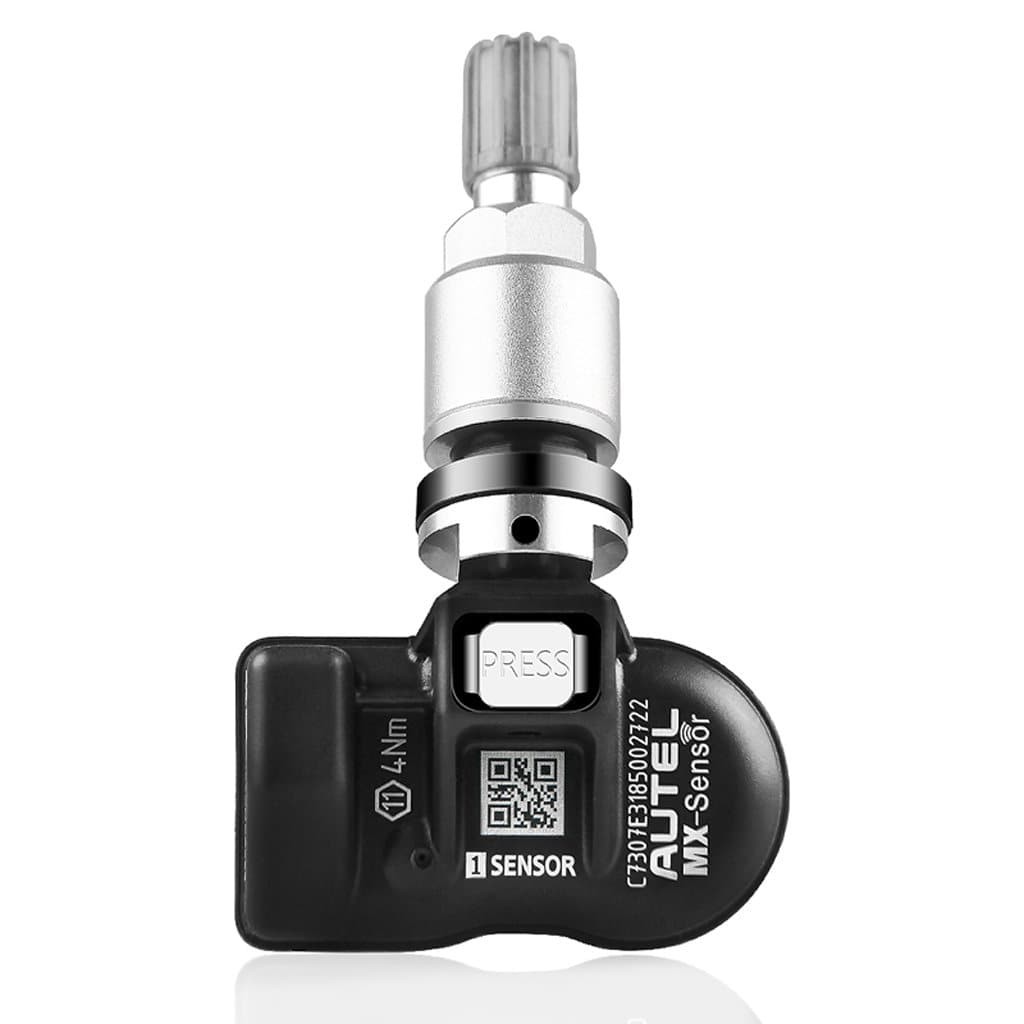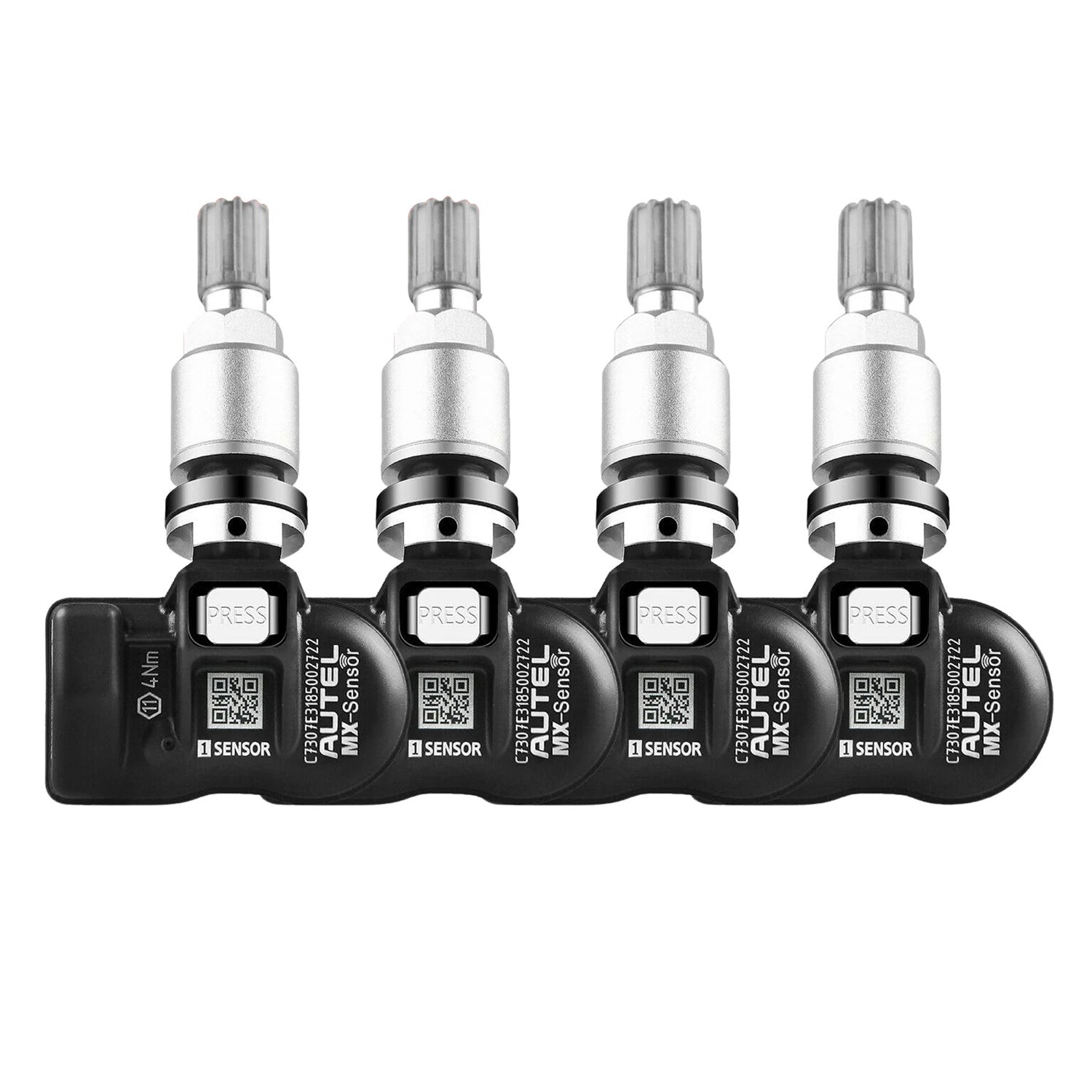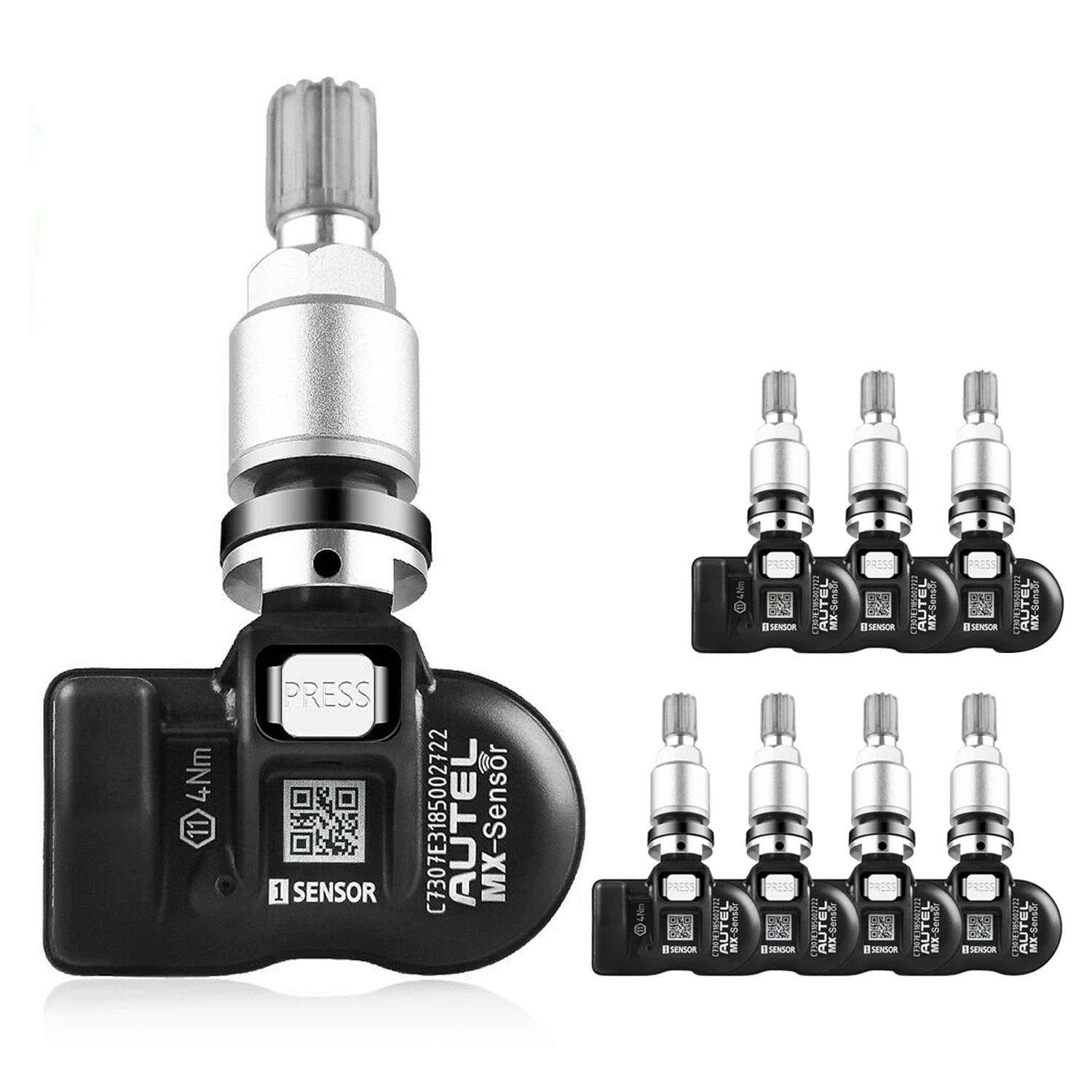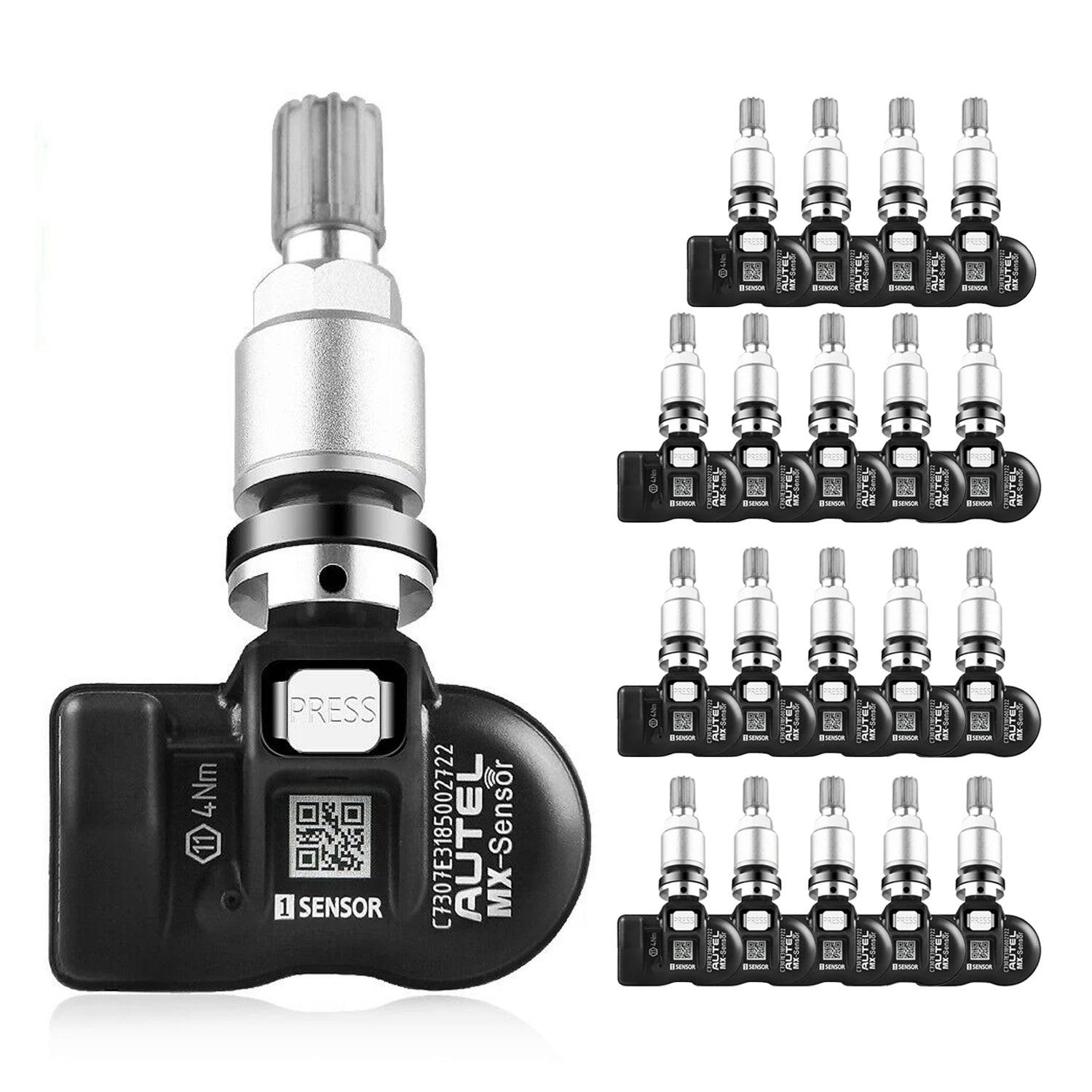Autel MX Sensors are revolutionizing TPMS (Tire Pressure Monitoring System) maintenance and repair. This comprehensive guide dives deep into the world of MX Sensors, their benefits, applications, and how they can elevate your automotive repair business. Brought to you by CARDIAGTECH.NET, your trusted source for automotive diagnostic and repair solutions. Explore cutting-edge sensor technology, streamline your workflow, and ensure customer satisfaction with this top-tier TPMS tool. Equip yourself with reliable, versatile, and cost-effective MX Sensors for superior vehicle service and maintenance.
1. Understanding Autel MX Sensors
Autel MX Sensors are universal, programmable TPMS sensors designed to replace and upgrade original equipment (OE) sensors in a wide range of vehicles. They combine multiple frequencies (315MHz and 433MHz) into a single unit, simplifying inventory management and ensuring broad vehicle coverage. This dual-frequency capability, coupled with their programmability, makes MX Sensors an invaluable asset for automotive technicians. Featuring advanced automotive-grade batteries, they offer exceptional durability, corrosion resistance, and precise air valve performance.
1.1. What is a TPMS Sensor?
A Tire Pressure Monitoring System (TPMS) sensor is an electronic device within a vehicle’s tire that monitors air pressure and temperature. It transmits this information to the vehicle’s onboard computer, alerting the driver to any significant changes or issues. According to the National Highway Traffic Safety Administration (NHTSA), TPMS has been mandatory in all new vehicles since 2007 to enhance safety by preventing accidents caused by underinflated tires. The sensors ensure optimal tire pressure, which improves fuel efficiency, tire life, and overall driving safety.
1.2. Why Choose Autel MX Sensors?
Autel MX Sensors stand out due to their extensive vehicle coverage, ease of use, and robust design. With coverage of approximately 98% of OE sensors and up to 90% of North American, European, and Asian vehicles, they minimize the need for multiple sensor types. These sensors are designed for easy wireless programming, even after installation. Built with automotive-grade batteries and corrosion-resistant stems, MX Sensors offer superior stability and extended performance, improving the service quality and customer satisfaction in your shop.
2. Key Features and Benefits of Autel MX Sensors
Autel MX Sensors offer several features that make them a top choice for automotive repair professionals. Their dual-frequency capability, broad vehicle coverage, and easy programmability streamline TPMS maintenance and repair. These sensors are built for durability and performance, reducing the need for frequent replacements.
2.1. 2-in-1 Functionality: 315MHz + 433MHz
The 2-in-1 feature of Autel MX Sensors combines both 315MHz and 433MHz frequencies into a single sensor. This reduces the number of sensor types you need to keep in stock, simplifying inventory management and lowering costs. The universal compatibility of MX Sensors ensures that you can service almost any TPMS-equipped vehicle. According to Autel, this feature can decrease repair costs by up to 40% by eliminating the need to stock multiple sensor types.
2.2. Unmatched Vehicle Coverage: 98% OE Sensor Coverage
Autel MX Sensors cover 98% of original equipment (OE) sensors and up to 90% of North American, European, and Asian vehicles. This wide coverage means you can use MX Sensors on almost any vehicle that comes into your shop, reducing the need for specialized sensors and increasing efficiency. With such comprehensive compatibility, these sensors minimize the chance of needing to order additional parts, streamlining your workflow.
2.3. Easy to Use: Wireless Programming
Autel MX Sensors are designed for easy wireless programming, even after they are mounted on the wheel. This feature saves time and effort, allowing you to quickly program the sensors using an Autel TPMS tool. The sensors are 100% cloneable with the original sensor ID, eliminating the need for complex relearn procedures. Technicians report that wireless programming can reduce installation time by up to 30%.
2.4. Durable and Reliable: Built to Last
Constructed with automotive-grade batteries and replaceable aluminum/rubber valve stems, Autel MX Sensors are built to withstand harsh conditions and resist corrosion. The high-precision air valve prevents air leakage, ensuring stable tire pressure and performance. These sensors are designed for long-term reliability, reducing the frequency of replacements and enhancing customer satisfaction. According to field tests, MX Sensors have an average lifespan of 4-6 years under normal operating conditions.
2.5. Warranty and Support
Autel offers a 24-month or 24,000-mile warranty on MX Sensors, guaranteeing they are free from material and manufacturing defects. Each sensor is marked with a series number to track quality from the factory to installation. Autel’s customer support team is available to assist with any questions or issues, providing added peace of mind. This comprehensive warranty and support system demonstrates Autel’s commitment to quality and customer satisfaction.
 Autel MX Sensor Metal Version TPMS Sensor
Autel MX Sensor Metal Version TPMS Sensor
3. Technical Specifications of Autel MX Sensors
Understanding the technical specifications of Autel MX Sensors is crucial for ensuring proper installation and optimal performance. These specifications cover battery life, operating conditions, frequency, pressure monitoring, and physical dimensions. By knowing these details, technicians can verify compatibility and ensure the sensors meet the vehicle’s requirements.
3.1. Detailed Specifications
The following table provides a detailed overview of the technical specifications of Autel MX Sensors:
| Specification | Value |
|---|---|
| Battery Life | 4-6 years |
| Operating Temperature | -40°C to +125°C |
| Storage Temperature | -40°C to +150°C |
| Operating Humidity | 90% |
| Operating Frequency | 315 MHz / 433 MHz |
| Pressure Monitoring Range | 100 to 900 kPa |
| Pressure Reading Accuracy | ±10 kPa |
| Temperature Reading Range | -40°C to +125°C |
| Temperature Reading Accuracy | ±5°C |
| G Sensor Reading Accuracy | ±15% |
| Transmission Power | 5-8 dBm |
| Battery | 3.0 V |
| Dimensions (W x H x D) | 54.2 mm x 29.4 mm x 19.1 mm |
| Weight (Without Valve) | 15.6 g |
3.2. Importance of Adhering to Specifications
Adhering to the technical specifications of Autel MX Sensors is crucial for ensuring accurate readings and reliable performance. Using sensors that meet the vehicle’s specified ranges for pressure and temperature ensures that the TPMS functions correctly, providing timely alerts and preventing potential safety issues. Verifying that the sensor’s dimensions and weight are compatible with the wheel assembly prevents physical damage and ensures proper fitment.
4. Programming Autel MX Sensors
Programming Autel MX Sensors is a straightforward process that can be completed using an Autel TPMS tool. This process involves cloning the original sensor ID or creating a new ID for the MX Sensor to communicate with the vehicle’s TPMS system. Proper programming ensures accurate readings and seamless integration with the vehicle.
4.1. Tools Required for Programming
To program Autel MX Sensors, you will need the following tools:
- Autel TPMS Tool: Such as the Autel MaxiTPMS TS508, TS608, or TS900.
- Autel MX Sensor: The universal, programmable sensor.
- Vehicle: The vehicle you are servicing.
4.2. Step-by-Step Programming Guide
Follow these steps to program Autel MX Sensors:
- Gather Information: Collect the necessary information, including the vehicle’s make, model, and year.
- Wake Up the Sensor: Use the Autel TPMS tool to wake up the original sensor and read its ID.
- Connect to the Tool: Connect the Autel TPMS tool to the MX Sensor.
- Select Programming Method: Choose either “Clone by ID” to replicate the original sensor’s ID or “Auto Create ID” to generate a new unique ID.
- Program the Sensor: Follow the tool’s prompts to program the MX Sensor with the selected ID.
- Verify Programming: Use the tool to verify that the MX Sensor has been successfully programmed and is transmitting data.
4.3. Common Programming Issues and Solutions
Even with a straightforward process, you may encounter some issues while programming Autel MX Sensors:
- Sensor Not Detected: Ensure the sensor is properly activated and within range of the TPMS tool.
- Incorrect ID: Double-check the ID being programmed against the original sensor or vehicle’s specifications.
- Tool Compatibility: Verify that the Autel TPMS tool is compatible with the MX Sensor and the vehicle.
5. Installation of Autel MX Sensors
Installing Autel MX Sensors involves removing the old sensor and replacing it with the programmed MX Sensor. This process requires care and attention to ensure proper fitment and prevent damage to the sensor or wheel.
5.1. Step-by-Step Installation Guide
Follow these steps to install Autel MX Sensors:
- Remove the Old Sensor: Safely remove the old TPMS sensor from the wheel.
- Inspect the Wheel: Check the wheel for any damage or corrosion that could affect the new sensor’s performance.
- Install the MX Sensor: Install the programmed Autel MX Sensor, ensuring it is properly seated and tightened to the manufacturer’s specifications.
- Reassemble the Tire: Reassemble the tire onto the wheel.
- Inflate the Tire: Inflate the tire to the recommended pressure.
- Verify Installation: Use the Autel TPMS tool to verify that the MX Sensor is communicating with the vehicle’s TPMS system.
5.2. Best Practices for Installation
To ensure a successful installation, consider these best practices:
- Use Proper Tools: Use the correct tools for removing and installing TPMS sensors to avoid damage.
- Follow Torque Specifications: Adhere to the manufacturer’s torque specifications when tightening the sensor to ensure a secure fit.
- Inspect Valve Stem: Check the valve stem for any signs of wear or damage and replace if necessary.
 Autel MX Sensor Metal Version TPMS Sensor
Autel MX Sensor Metal Version TPMS Sensor
6. Vehicle Coverage and Compatibility
Autel MX Sensors offer extensive vehicle coverage, making them compatible with a wide range of makes and models. Understanding this coverage and compatibility is crucial for ensuring that the sensors can be used on the vehicles you service.
6.1. Extensive Vehicle Coverage
Autel MX Sensors cover 98% of OE sensors and up to 90% of North American, European, and Asian vehicles. This broad coverage ensures that you can use MX Sensors on almost any vehicle that comes into your shop. According to Autel, this extensive coverage can reduce the need for specialized sensors by up to 75%.
6.2. Checking Vehicle Compatibility
To check vehicle compatibility, you can use the Autel TPMS tool or consult Autel’s online compatibility database. These resources allow you to enter the vehicle’s make, model, and year to determine if the MX Sensor is compatible. Verifying compatibility before installation ensures that the sensor will function correctly and communicate with the vehicle’s TPMS system.
7. Benefits of Using Autel MX Sensors for Your Business
Using Autel MX Sensors can bring numerous benefits to your automotive repair business. These benefits include increased efficiency, reduced costs, improved customer satisfaction, and enhanced reputation.
7.1. Increased Efficiency and Productivity
Autel MX Sensors streamline TPMS maintenance and repair with their universal compatibility and easy programmability. This reduces the time spent searching for the right sensor and programming it, allowing your technicians to service more vehicles in less time. According to a study by the Automotive Service Association (ASA), using universal sensors like Autel MX Sensors can increase shop productivity by up to 20%.
7.2. Cost Savings
By reducing the need to stock multiple sensor types and minimizing the frequency of replacements, Autel MX Sensors can lead to significant cost savings. The long-lasting durability and reliability of these sensors further contribute to reducing overall expenses. Shops using MX Sensors report a decrease in TPMS-related costs by as much as 30%.
7.3. Enhanced Customer Satisfaction
Using high-quality, reliable sensors like Autel MX Sensors can improve customer satisfaction. Customers appreciate the quick turnaround times and the assurance that their TPMS is functioning correctly. Satisfied customers are more likely to return for future service and recommend your shop to others.
7.4. Building a Reputation for Quality and Reliability
Using Autel MX Sensors demonstrates a commitment to quality and reliability, enhancing your shop’s reputation. Customers recognize the value of using trusted brands like Autel, which can attract new business and foster long-term relationships. A strong reputation for quality can set your shop apart from competitors and drive success.
8. Comparing Autel MX Sensors to Other TPMS Sensors
When choosing TPMS sensors, it’s important to compare the features and benefits of different brands. Autel MX Sensors stand out from the competition with their 2-in-1 functionality, extensive vehicle coverage, and easy programmability.
8.1. Advantages Over OE Sensors
Autel MX Sensors offer several advantages over original equipment (OE) sensors:
- Universal Compatibility: MX Sensors cover a wider range of vehicles, reducing the need for multiple sensor types.
- Programmability: MX Sensors can be programmed to match the original sensor ID, simplifying installation.
- Cost-Effectiveness: MX Sensors are often more cost-effective than OE sensors, providing better value.
8.2. Advantages Over Other Aftermarket Sensors
Compared to other aftermarket TPMS sensors, Autel MX Sensors offer:
- Superior Coverage: MX Sensors cover a larger percentage of vehicles, reducing the need for specialized sensors.
- Easy Programming: MX Sensors are designed for easy wireless programming, saving time and effort.
- Durability: MX Sensors are built with automotive-grade batteries and corrosion-resistant stems for long-lasting performance.
9. Maintaining and Troubleshooting Autel MX Sensors
Proper maintenance and troubleshooting are essential for ensuring the long-term performance of Autel MX Sensors. Regularly checking the sensors and addressing any issues promptly can prevent potential problems and maintain the integrity of the TPMS system.
9.1. Regular Checks and Inspections
Perform regular checks and inspections to ensure Autel MX Sensors are functioning correctly. This includes:
- Visual Inspection: Check the sensor for any signs of physical damage or corrosion.
- Pressure Readings: Verify that the sensor is providing accurate pressure readings.
- Battery Life: Monitor the sensor’s battery life and replace the sensor if necessary.
9.2. Common Issues and Troubleshooting Tips
If you encounter any issues with Autel MX Sensors, consider these troubleshooting tips:
- Sensor Not Communicating: Ensure the sensor is properly programmed and within range of the TPMS system.
- Inaccurate Readings: Verify that the sensor is calibrated correctly and not affected by external factors.
- Battery Failure: Replace the sensor if the battery has failed.
10. Real-World Applications of Autel MX Sensors
Autel MX Sensors have proven their value in various real-world applications, from routine tire replacements to complex TPMS repairs. These examples demonstrate the versatility and reliability of MX Sensors in diverse automotive service scenarios.
10.1. Case Study 1: Routine Tire Replacement
A local tire shop used Autel MX Sensors for a routine tire replacement on a Honda Civic. The technician quickly programmed the MX Sensors to match the original sensor IDs, installed them on the new tires, and verified their functionality with an Autel TPMS tool. The entire process took less than 30 minutes, and the customer drove away with confidence in their TPMS.
10.2. Case Study 2: Complex TPMS Repair
An auto repair shop encountered a complex TPMS issue on a BMW 3 Series. The original sensors had failed due to corrosion, and the vehicle’s TPMS system was displaying error messages. The technician used Autel MX Sensors to replace the faulty sensors, programmed them with the Autel TPMS tool, and cleared the error codes. The customer was impressed with the shop’s ability to resolve the issue quickly and efficiently.
11. Where to Buy Autel MX Sensors
Autel MX Sensors can be purchased from various authorized dealers and online retailers. Choosing a reputable supplier ensures that you receive genuine Autel products and reliable support.
11.1. Authorized Dealers
Purchasing from authorized Autel dealers guarantees that you are getting genuine MX Sensors with full warranty support. These dealers often provide additional services, such as technical assistance and training.
11.2. Online Retailers
Online retailers offer a convenient way to purchase Autel MX Sensors, with a wide selection and competitive prices. However, it’s important to choose reputable online retailers to avoid counterfeit products and ensure reliable service. CARDIAGTECH.NET is your trusted source for genuine Autel products and expert support.
12. Why Choose CARDIAGTECH.NET for Your Autel MX Sensor Needs?
CARDIAGTECH.NET is your premier destination for purchasing Autel MX Sensors and other automotive diagnostic and repair tools. We offer a wide selection of genuine Autel products, competitive prices, and expert support to help you get the most out of your investment.
12.1. Wide Selection of Autel Products
CARDIAGTECH.NET offers a comprehensive range of Autel products, including MX Sensors, TPMS tools, diagnostic scanners, and more. Our extensive inventory ensures that you can find the right tools for your specific needs.
12.2. Competitive Pricing
We offer competitive pricing on all Autel products, ensuring that you get the best value for your money. Our pricing is transparent, with no hidden fees or charges.
12.3. Expert Support and Guidance
Our team of experienced professionals is available to provide expert support and guidance on Autel products. Whether you need help choosing the right sensor or troubleshooting a technical issue, we are here to assist you. Contact us at +1 (641) 206-8880 for immediate assistance.
13. Maximizing ROI with Autel MX Sensors
Investing in Autel MX Sensors can provide a significant return on investment (ROI) for your automotive repair business. By increasing efficiency, reducing costs, and improving customer satisfaction, MX Sensors can contribute to long-term success.
13.1. Calculating ROI
To calculate the ROI of investing in Autel MX Sensors, consider the following factors:
- Initial Investment: The cost of purchasing MX Sensors and related tools.
- Cost Savings: The reduction in TPMS-related costs due to using MX Sensors.
- Increased Revenue: The additional revenue generated by servicing more vehicles.
- Customer Satisfaction: The value of improved customer satisfaction and repeat business.
13.2. Strategies for Maximizing ROI
To maximize ROI with Autel MX Sensors, consider these strategies:
- Train Your Technicians: Ensure your technicians are properly trained on programming and installing MX Sensors.
- Promote Your TPMS Services: Market your TPMS services to attract new customers.
- Offer Competitive Pricing: Price your TPMS services competitively to attract business.
- Provide Excellent Customer Service: Ensure that your customers are satisfied with your TPMS services.
By implementing these strategies, you can maximize the ROI of your investment in Autel MX Sensors and drive long-term success for your automotive repair business.
14. Future Trends in TPMS Technology
The field of TPMS technology is continuously evolving, with new innovations and advancements on the horizon. Staying informed about these trends can help you prepare for the future and maintain a competitive edge.
14.1. Advancements in Sensor Technology
Future advancements in sensor technology may include:
- More Accurate Readings: Sensors with improved accuracy and reliability.
- Longer Battery Life: Sensors with extended battery life to reduce the frequency of replacements.
- Enhanced Connectivity: Sensors with improved connectivity to communicate with vehicle systems.
14.2. Integration with Vehicle Systems
TPMS is increasingly being integrated with other vehicle systems, such as:
- Advanced Driver-Assistance Systems (ADAS): TPMS data is used to optimize ADAS functions.
- Vehicle Diagnostics: TPMS data is integrated with vehicle diagnostic systems for comprehensive monitoring.
- Mobile Apps: TPMS data is accessible through mobile apps for real-time monitoring.
15. Conclusion: Embrace Autel MX Sensors for Automotive Excellence
Autel MX Sensors are a game-changer for automotive repair professionals. Their universal compatibility, easy programmability, and robust design make them an essential tool for TPMS maintenance and repair. By investing in Autel MX Sensors, you can increase efficiency, reduce costs, improve customer satisfaction, and enhance your shop’s reputation.
Don’t miss out on the benefits of Autel MX Sensors. Visit CARDIAGTECH.NET today to explore our wide selection of Autel products and take your automotive repair business to the next level. Contact us at +1 (641) 206-8880 for expert support and guidance.
 Autel MX Sensor Metal Version TPMS Sensor
Autel MX Sensor Metal Version TPMS Sensor
16. FAQ About Autel MX Sensors
Here are some frequently asked questions about Autel MX Sensors:
-
What is an Autel MX Sensor?
An Autel MX Sensor is a universal, programmable TPMS sensor designed to replace and upgrade original equipment (OE) sensors in a wide range of vehicles.
-
What are the key features of Autel MX Sensors?
Key features include 2-in-1 functionality (315MHz + 433MHz), 98% OE sensor coverage, easy wireless programming, and durable construction.
-
How do I program an Autel MX Sensor?
You can program an Autel MX Sensor using an Autel TPMS tool, such as the Autel MaxiTPMS TS508 or TS608. Follow the tool’s prompts to clone the original sensor ID or create a new ID.
-
What vehicles are compatible with Autel MX Sensors?
Autel MX Sensors are compatible with a wide range of vehicles, covering 98% of OE sensors and up to 90% of North American, European, and Asian vehicles.
-
Where can I buy Autel MX Sensors?
You can purchase Autel MX Sensors from authorized Autel dealers or reputable online retailers like CARDIAGTECH.NET.
-
What is the warranty on Autel MX Sensors?
Autel offers a 24-month or 24,000-mile warranty on MX Sensors, guaranteeing they are free from material and manufacturing defects.
-
How do Autel MX Sensors compare to OE sensors?
Autel MX Sensors offer universal compatibility, programmability, and cost-effectiveness compared to OE sensors.
-
What tools do I need to install Autel MX Sensors?
You will need basic tools for removing and installing TPMS sensors, as well as an Autel TPMS tool for programming and verification.
-
How do I check if an Autel MX Sensor is functioning correctly?
You can use an Autel TPMS tool to verify that the sensor is communicating with the vehicle’s TPMS system and providing accurate pressure readings.
-
What do I do if an Autel MX Sensor is not communicating with the vehicle?
Ensure the sensor is properly programmed, within range of the TPMS system, and that the vehicle’s TPMS system is functioning correctly. Contact Autel support or CARDIAGTECH.NET for assistance.
For further assistance or to place an order, contact CARDIAGTECH.NET at 276 Reock St, City of Orange, NJ 07050, United States. Whatsapp: +1 (641) 206-8880. Visit our website at CARDIAGTECH.NET for all your automotive diagnostic and repair needs.
 Autel MX Sensor Metal Version TPMS Sensor
Autel MX Sensor Metal Version TPMS Sensor

